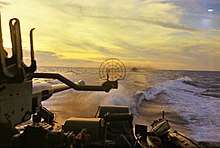United States Nasty-class patrol boat
| Class overview | |
|---|---|
| Builders: |
Westermoen Båtbyggeri, Mandal, Norway John Trumpy & Sons, Annapolis, Maryland |
| Operators: |
|
| Built: | 1962–1968 |
| In commission: | 1962–1981 |
| Completed: | 20 |
| General characteristics [1] | |
| Type: | Patrol boat |
| Displacement: | 80 long tons (81 t) |
| Length: | 80 ft 4 in (24.49 m) |
| Beam: | 24 ft 7 in (7.49 m) |
| Draft: | 3 ft 10 in (1.17 m) |
| Propulsion: | 2 × Napier Deltic Turboblown diesel engines, 6,200 bhp (4,623 kW) |
| Speed: | 38 knots (70 km/h; 44 mph) |
| Complement: | 17 men |
| Armament: |
|
- For other ship classes of the same name see Nasty-type patrol boat
The Nasty class of fast patrol boats were a set of 20 vessels built for the United States Navy to a Norwegian design and purchased in the 1960s for "unorthodox operations" during the Vietnam War. Following the conflict they remained in service until the early 1980s.
Construction

Following World War II the US Navy had little use for fast attack craft, and most of her PT boats were disposed of shortly after VJ Day. With the involvement in the Vietnam War the Navy saw a renewed need for small combatant craft for "brown water" operations, and they approached the Norwegian Westermoen company, which had built a prototype fast attack boat, the Nasty, and was currently building a set of 12 vessels (the Tjeld-class patrol boats) for the Royal Norwegian Navy.
The USN ordered two vessels, which were delivered in 1962 and were designated PTF 3 and PTF 4. This was followed in 1966 with an order for 14 more (PTF's 5-16), with an agreement for a further six to be built under licence by Trumpy of Annapolis. Trumpy's had been a major contributor to the USN's PT fleet in World War II, and had been one of just four yards asked post-war to build a prototype PT boat to consolidate wartime experience and the lessons learned.
The Norwegian boats were delivered in 1964, and the Trumpy boats three years later.[1]
A subsequent improved version, the Osprey class, was larger with aluminum instead of wooden hulls, of which four were operated by the U.S.Navy, assigned hull numbers PTF-23 through PTF-26.[3]
Service history

All vessels of the class saw action during the war in Vietnam, being employed by Special Forces for clandestine operations along the coast of North Vietnam. During these operations six boats were lost; one (PTF 4) in 1964 and five more in 1966. In 1966 four boats were transferred to the South Vietnamese Navy, though they were returned and re-commissioned in 1970.
With the end of the conflict the need for these boats evaporated, and the high maintenance costs of such vessels militated against retaining them. Most were disposed of in the 1970s and all were gone by 1981.[1]
List of vessels
| Number | Date of acquisition | Builder | Notes[1] |
|---|---|---|---|
| PTF 3 | December 1962 | Westermoen | Transferred to South Vietnamese Navy January 1966, returned 1970. Stricken 1977 |
| PTF 4 | December 1962 | Westermoen | Sunk 1964 |
| PTF 5 | March 1964 | Westermoen | Transferred to South Vietnamese Navy January 1966, returned 1970. Stricken 1981 |
| PTF 6 | March 1964 | Westermoen | Transferred to South Vietnamese Navy January 1966, returned 1970. Stricken 1977 |
| PTF 7 | March 1964 | Westermoen | Transferred to South Vietnamese Navy January 1966, returned 1970. Stricken 1977 |
| PTF 8 | March 1964 | Westermoen | Sunk 1966 |
| PTF 9 | September 1964 | Westermoen | Sunk 1966 |
| PTF 10 | September 1964 | Westermoen | Stricken 1981 |
| PTF 11 | September 1964 | Westermoen | Stricken 1981 |
| PTF 12 | September 1964 | Westermoen | Stricken 1977 |
| PTF 13 | September 1964 | Westermoen | Stricken 1981 |
| PTF 14 | September 1964 | Westermoen | Sunk 1966 |
| PTF 15 | September 1964 | Westermoen | Sunk 1966 |
| PTF 16 | September 1964 | Westermoen | Sunk 1966 |
| PTF 17 | 1967 | Trumpy | Stricken 1981 |
| PTF 18 | 1967 | Trumpy | Stricken 1980 |
| PTF 19 | 1967 | Trumpy | Stricken 1980 |
| PTF 20 | 1967 | Trumpy | Stricken 1981 |
| PTF 21 | 1968 | Trumpy | Stricken 1981 |
| PTF 22 | 1968 | Trumpy | Stricken 1981 |
Notes
References
- Gardiner, Robert; Chumbley, Stephen Conway's All The World's Fighting Ships 1947–1995 (1995) Naval Institute Press, Annapolis ISBN 1-55750-132-7